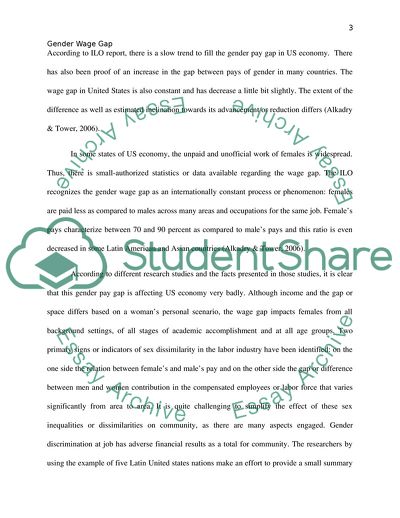
Feb 21, · Introduction. The gender pay gap, the disparity in earnings between male and female workers, has been the focus of empirical research in the US for decades, as well as legislative and executive action under the Obama administration [1, 2].Trends dating back to the s show a long period in which women’s earnings were approximately 60% of their male counterparts, followed by Apr 10, · States like Alaska, Illinois, Minnesota, and New Hampshire already collect and publish data on the pay gap. 21 However, data transparency proposals have recently received pushback. In , California Governor Jerry Brown vetoed AB , the Gender Pay Gap Transparency Act, in a state with one of the strongest equal pay environments in the country Gender pay differences. Gender inequalities still exist as social problems and are still growing in places. In , recently qualified female doctors in New York State had a starting salary $16, less than their male counterparts. An increase compared to the $3, difference of
Gender pay gap - Wikipedia
By clicking the "Accept" button or continuing to browse our site, you agree to first-party and session-only cookies being stored on your device to enhance site navigation and analyze site performance and traffic. For more information on our use of cookies, please see our Privacy Policy. This website uses cookies. Home Journals Journal of Economic Literature September The Gender Wage Gap: Extent, Trends, and Explanations. The Gender Wage Gap: Extent, Trends, and Explanations Francine D.
Blau Lawrence M. Kahn Journal of Economic Literature vol. Article Information Abstract Using Panel Study of Income Dynamics PSID microdata over the period, we provide new empirical evidence on the extent of and trends in the gender wage gap, which declined considerably during this time.
Byconventional human capital variables taken together explained little of the gender wage gap, while gender differences in occupation and industry continued to be important. Moreover, the gender pay gap declined much more slowly at the top of the wage distribution than at the middle or bottom and by was noticeably higher at the top. We then survey the literature to identify what has been learned about the explanations for the gap.
We conclude that many of the traditional explanations continue to have salience. Although human-capital factors are now relatively unimportant in the aggregate, women's work force interruptions and shorter hours remain significant in high-skilled occupations, possibly due to compensating differentials.
Gender differences in occupations and industries, as well as differences in gender roles and the gender division of labor remain important, and research based on experimental evidence strongly suggests that discrimination cannot be discounted. Psychological attributes or noncognitive skills comprise one of the newer explanations for gender differences in outcomes. Our effort to assess the quantitative evidence on the importance of these factors suggests that they account for a small to moderate portion of the gender gender pay gap literature review gap, considerably smaller than, say, occupation and industry effects, gender pay gap literature review, though they appear to modestly contribute to these differences.
Citation Blau, gender pay gap literature review, Francine D. DOI:
There Is No Gender Wage Gap
, time: 5:30The Gender Wage Gap: Extent, Trends, and Explanations - American Economic Association

Key pointsSex is a major factor influencing best performances and world records.A stabilization of the gender gap in world records is observed after , at a mean difference of % ± Nov 16, · Pay Gap When we think about the gender gap, one of the things that probably immediately comes to mind is the pay gap, which refers to the difference in wages and salaries between men and women Moreover, the gender pay gap declined much more slowly at the top of the wage distribution than at the middle or bottom and by was noticeably higher at the top. We then survey the literature to identify what has been learned about the explanations for the gap. We conclude that many of the traditional explanations continue to have salience
No comments:
Post a Comment